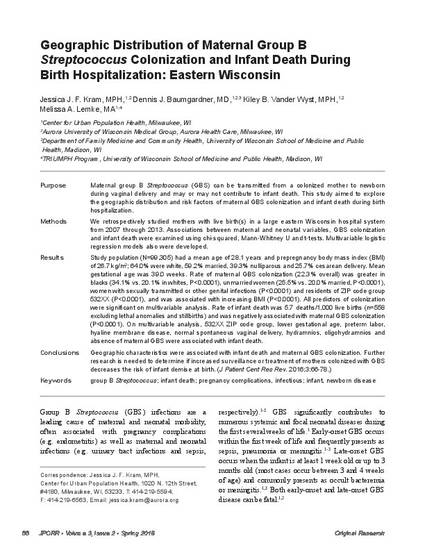
- group B Streptococcus (GBS); infant death; pregnancy complications,
- infectious; infant,
- newborn disease
Purpose
Maternal group B Streptococcus (GBS) can be transmitted from a colonized mother to newborn during vaginal delivery and may or may not contribute to infant death. This study aimed to explore the geographic distribution and risk factors of maternal GBS colonization and infant death during birth hospitalization.
Methods
We retrospectively studied mothers with live birth(s) in a large eastern Wisconsin hospital system from 2007 through 2013. Associations between maternal and neonatal variables, GBS colonization and infant death were examined using chi-squared, Mann-Whitney U and t-tests. Multivariable logistic regression models also were developed.
Results
Study population (N = 99,305) had a mean age of 28.1 years and prepregnancy body mass index (BMI) of 26.7 kg/m2; 64.0% were white, 59.2% married, 39.3% nulliparous and 25.7% cesarean delivery. Mean gestational age was 39.0 weeks. Rate of maternal GBS colonization (22.3% overall) was greater in blacks (34.1% vs. 20.1% in whites, P < 0.0001), unmarried women (25.5% vs. 20.0% married, P < 0.0001), women with sexually transmitted or other genital infections (P < 0.0001) and residents of ZIP code group 532XX (P < 0.0001), and was associated with increasing BMI (P < 0.0001). All predictors of colonization were significant on multivariable analysis. Rate of infant death was 5.7 deaths/1,000 live births (n = 558 excluding lethal anomalies and stillbirths) and was negatively associated with maternal GBS colonization (P < 0.0001). On multivariable analysis, 532XX ZIP code group, lower gestational age, preterm labor, hyaline membrane disease, normal spontaneous vaginal delivery, hydramnios, oligohydramnios and absence of maternal GBS were associated with infant death.
Conclusions
Geographic characteristics were associated with infant death and maternal GBS colonization. Further research is needed to determine if increased surveillance or treatment of mothers colonized with GBS decreases the risk of infant demise at birth.
Kram JJ, Baumgardner DJ, Vander Wyst KB, Lemke MA. Geographic distribution of maternal group B Streptococcus colonization and infant death during birth hospitalization: eastern Wisconsin. J Patient Cent Res Rev. 2016;3:66-78. doi: 10.17294/2330-0698.1252
